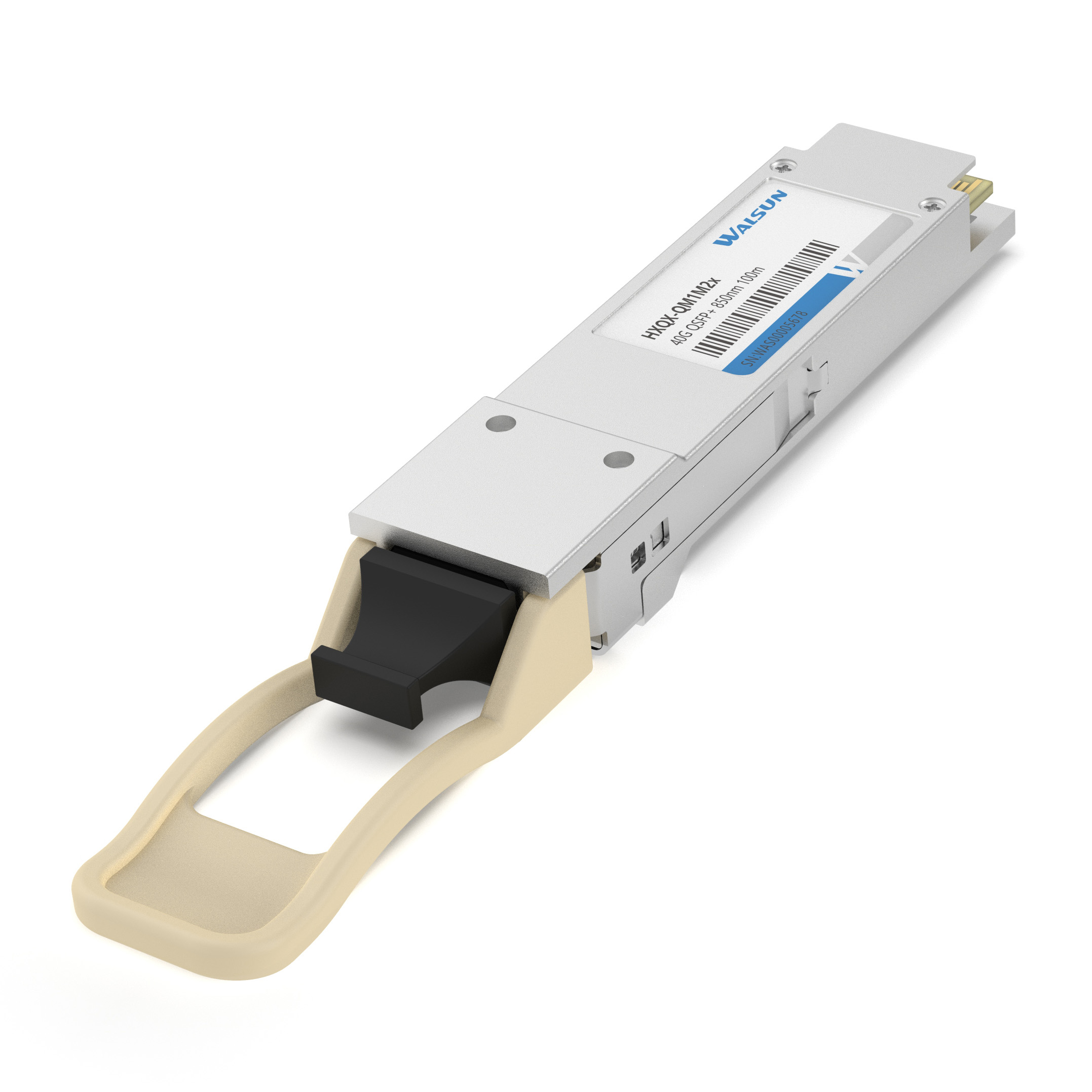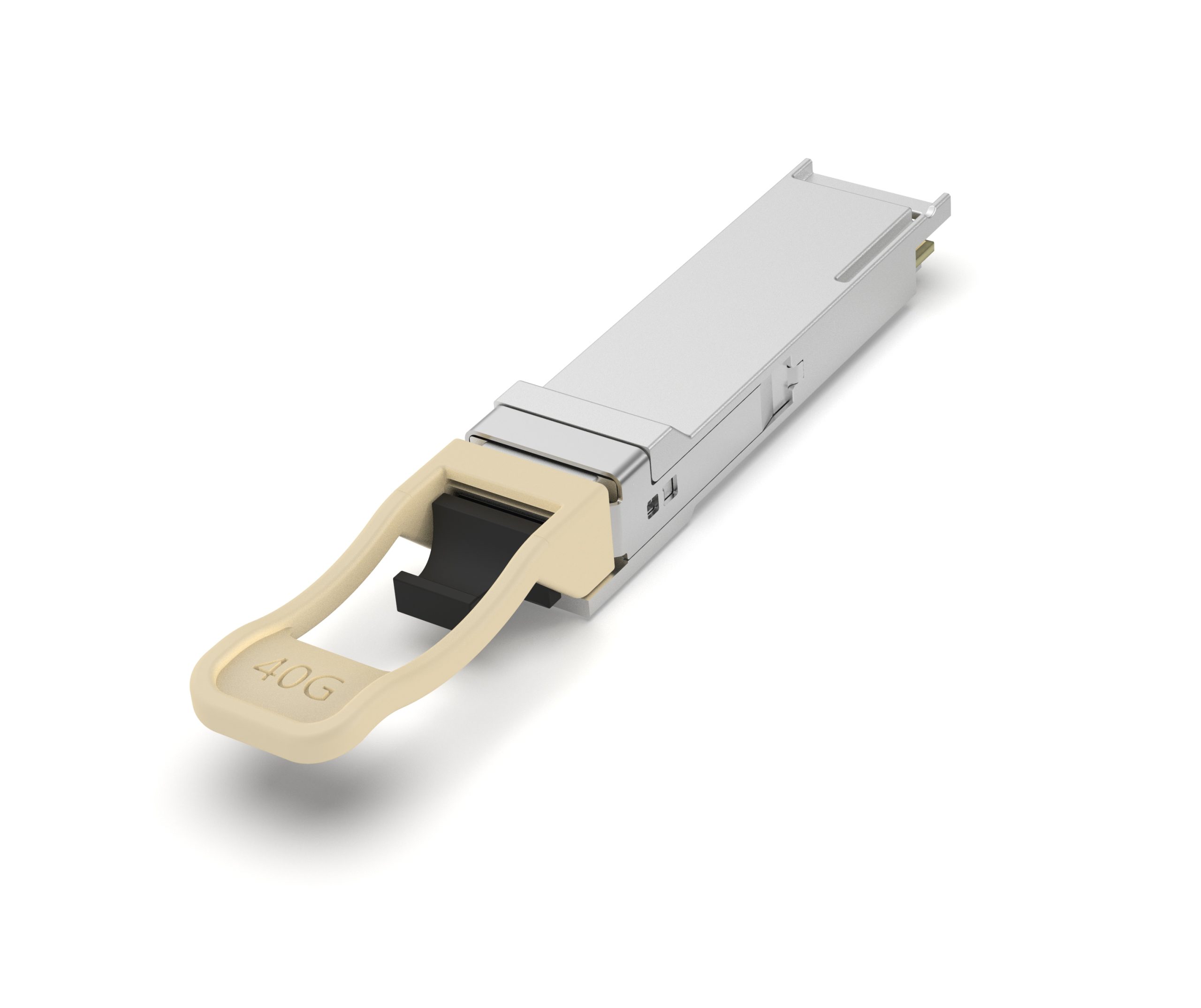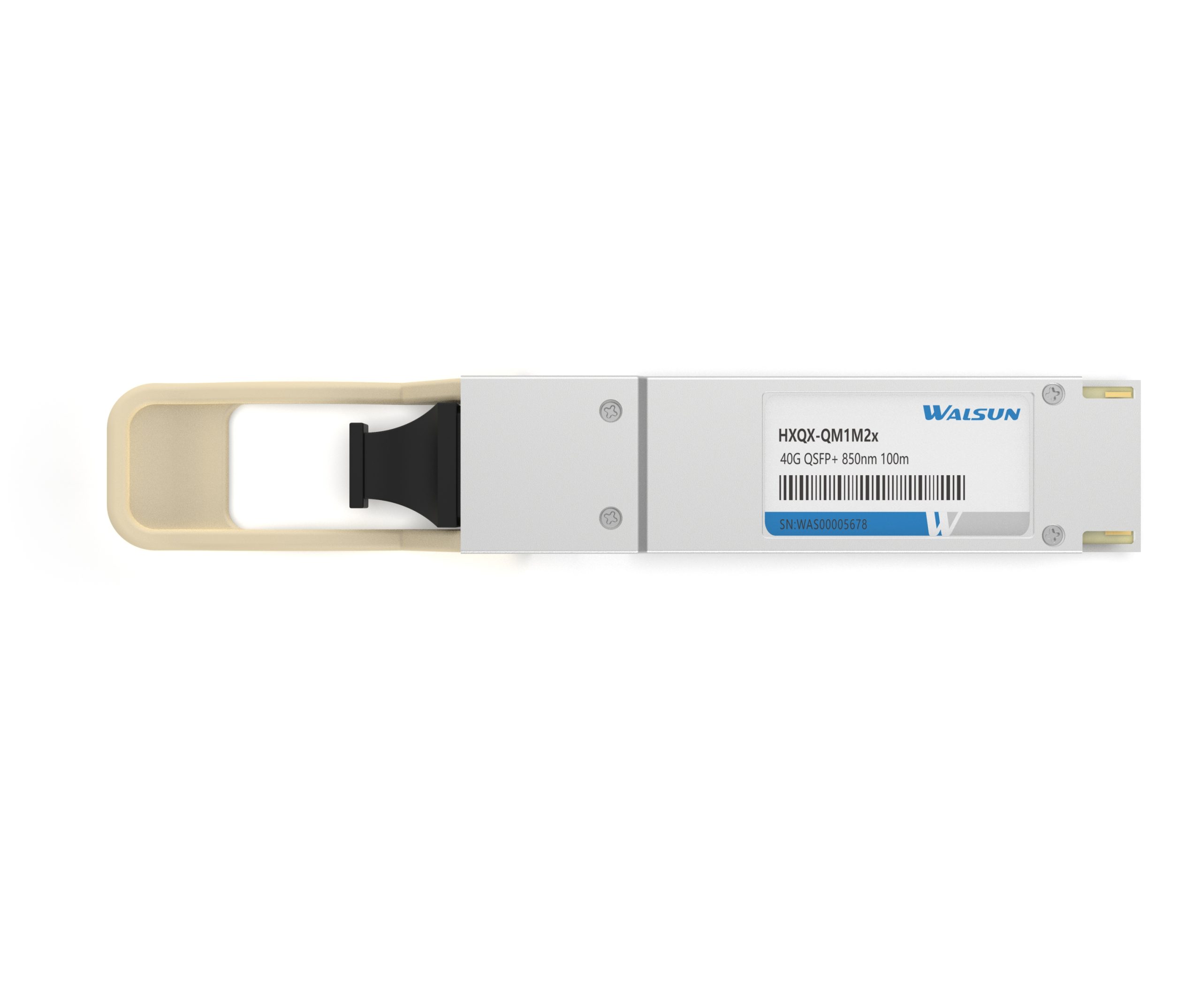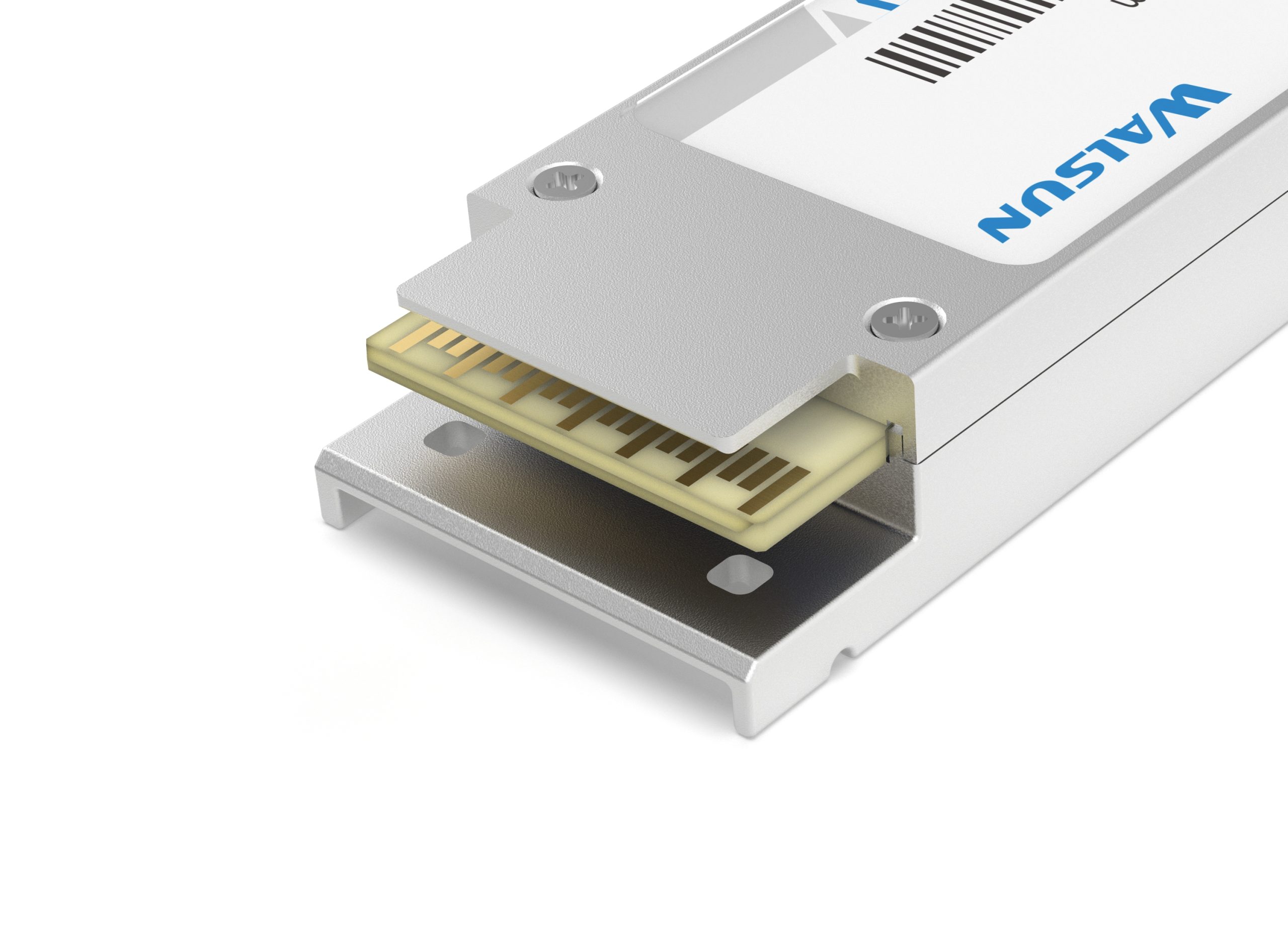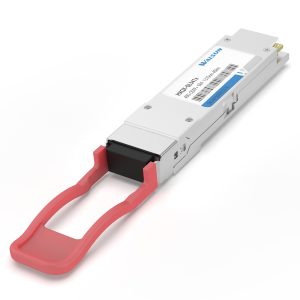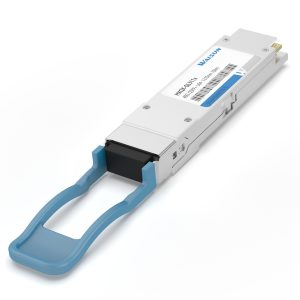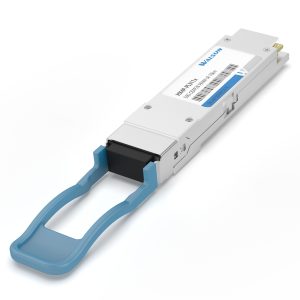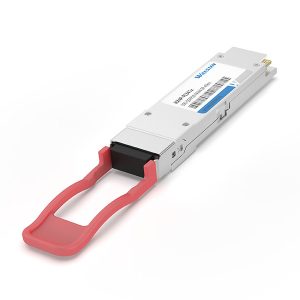40G QSFP+ SR4 850nm 100m
- Adopts hot-pluggable QSFP+ package
- Full-duplex transceiver module
- 850nm VCSEL transmitter and PIN receiver
- Complies with IEEE 802.3ba, SFF-8436, SFF-8636, and QSFP+ MSA Ethernet standards
- Maximum power consumption less than 1.5W
- Built-in Digital Diagnostic Monitoring (DDM)
- Power supply voltage 3.3V
- RoHS compliant (lead-free)
- Class 1/1M product, compliant with IEC60825-1 requirements
- Meets Telcordia (Bellcore) GR-468-CORE reliability requirements
- Meets EMI and ESD requirements
Warranty : 30-Day Free Return, 3-Year Free Replacement, 5-Year Warranty, Lifetime After-sales Technical Support.
| Product Model | QSFP-40G-SR4 | Vendor Name | Walsun |
| Form Factor | QSFP+ | Data Rate | 41.25Gbps |
| Wavelength | 850nm | Distance | 100m@OM3/150m@OM4 |
| Connector | MPO/MTP-12 | Cable Type | MMF |
| Transmitter Type | VCSEL | Detector Types | PIN |
| TX Power | -6~2.4dBm | Receiver Sensitivity | < -11.1dBm |
| Power Consumption | ≤1.5W | Operation Temperature | 0~70°C |
| DDM | Support | EMC | Support |
| Protocols | IEEE 802.3ba, SFF-8436, QSFP+ MSA, CPRI, eCPRI | ||
Q: Can a 40G-LR4 optical module be split into 4x10G connections?
A: No, a 40G-LR4 optical module cannot be split into 4x10G connections. The 40GBASE-LR4 operates using 4 wavelengths (or lambdas) over a pair of single-mode fibers and does not divide itself into four pairs unless wavelength division is implemented. The uniqueness of 40GBASE-SR4 lies in its use of parallel fibers, allowing for simultaneous use of 4 pairs of parallel fibers. Both 40G-PLRL4 and 40G-PLR4 standards support 4x10G, employing 12-fiber single-mode MTP ribbon fiber, and are fully compatible with 10GBASE-LR and 10G-LR, achieving their maximum transmission distances.
Q: What is the transmission performance of the 40GbE PLRL4 standard?
A: The 40G Parallel LR4 Lite (PLRL4), based on the 10GBASE-LR standard, offers a transmission distance of 1 kilometer over single-mode fiber. Additionally, 40GbE PLRL4 optical devices, by leveraging a 4x10G configuration, can support 4 independent 10G-LR connections via breakout cables or single-mode fiber boxes.
Q: What type of fiber does the PLRL4 and PLR4 optical module require?
A: PLR4 and PLRL4 utilize 12-fiber MTP optical connectors and require an APC (Angle Polished Connector) single-mode 12-fiber MTP fiber. This fiber is akin to a 40G-SR4 MTP-MTP fiber, with the distinction of using single-mode fiber instead. UPC (Ultra Physical Contact) fiber connectors are another type of 12-fiber MTP connector but are not suitable for single-mode fiber. APC is the only viable option for single-mode 12-fiber MTP fiber.
QSFP+ to QSFP+ and QSFP+ to 4SFP+ copper cables cater to short-distance connections, while for longer distances, ETU provides a full range of optical modules catering to various fiber types and distances.
Q: What are the pros and cons of QSFP+ DAC high-speed cables?
A: QSFP+ DAC high-speed cables offer benefits of low cost, low power consumption, high interchangeability, and plug-and-play functionality, but they are heavy, bulky, inconvenient for transportation, have limited transmission distances, and can be challenging to manage. QSFP+ AOC high-speed cables are lightweight, have greater bandwidth, and offer electromagnetic interference resistance, ensuring enhanced secure transmission performance.
Q: How to choose the appropriate QSFP+ DAC high-speed cable and QSFP+ AOC high-speed cable?
A: When the transmission distance is less than 15 meters, QSFP+ DAC high-speed cables present the most cost-effective solution. For distances between 15 meters and 100 meters, it’s recommended to use a 40G QSFP+ AOC high-speed cable. Beyond 100 meters, one can employ 40G SR4 optical modules with OM3 or OM4 fiber patch cords, or use 40GBASE LR4 optical modules with single-mode fiber patch cords to attain longer transmission distances.
Q: What are the typical solutions for a 40G network?
A: At the core of the 40G network layer, a common approach involves connecting a pair of optical modules (typically 40G QSFP+ modules) at each end of multimode fibers like OM3 or OM4, primarily utilized for long-distance transmissions. High-speed cables and active optical cables frequently serve as cost-saving alternatives to these optical modules and fibers for short-range interconnect applications.
| Product Number | Data Rate (Gb/s) |
Wavelength (nm) |
Reach (km) |
LD | Tx Power (dBm) |
PD | Rx Sens (dBm) |
Temperature (℃) |
Download |
| QSFP+ LR4 | 40 | 1310 | 10 | DFB | -7.0~2.3 | PIN | < -13.5 | 0~70/-40~85 | |
| QSFP+ ER4 | 40 | 1310 | 40 | DML | -2.7~4.5 | APD | < -19 | 0~70/-40~85 | |
| QSFP+ ZR4 | 40 | 1295.56 1300.05 1304.58 1309.14 |
80 | LAN WDM EML | 2.0~4.5 | SOA+PIN | < -24 | 0~70/-40~85 |
相关产品
-
40G Transceivers
40G QSFP+ ER4 40km
-
40G Transceivers
40G QSFP+ LR4 10km
-
50G QSFP28
50G QSFP28 PAM4 ER 1310nm 10km
-
50G QSFP28
50G QSFP28 PAM4 ER 1310nm 40km

